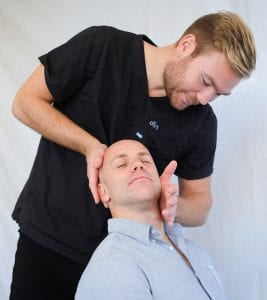Researchers find those who seek chiropractic care for pain are less likely to use opioids.
Researchers writing for the journal Pain Medicine recently analyzed data from six previously published studies with more than 62,000 participants with spinal pain and found 11% to 51% of the patients used chiropractic care. Those who reported chronic back and neck pain appeared to be less likely to use opioid painkillers if care was used. They also noted the individuals who visited a chiropractor regularly were 64% less likely to use opioids than people who didn’t.
“Patients with spinal pain who visit a chiropractor may receive treatments such as spinal manipulation, massage, acupuncture, exercises and education as appropriate,” said lead author Kelsey Corcoran of Yale School of Medicine. “These therapies may lead to decreased pain, improved range of motion and increased function. If a patient’s pain is well controlled by the treatment they received from a chiropractor, they may subsequently need less pain medications or even none at all.”
The previously published studies used in the most recently review examined whether chiropractic care was solicited in tandem with receiving opioid prescriptions from other physicians. The study failed to examine whether patients using opioid medications to manage their pain might be able to cut back or eliminate use after receiving chiropractic care. While the study also did not specify the exact type of chiropractic methods sought or the level of pain the patients were in when they sought care, in four of the six studies, chiropractors were either the first provider patients saw or part of the initial treatment plan.

“Patients visiting chiropractors are likely to be different than those visiting MDs in terms of their pain complexity,” said Dan Cherkin, an emeritus senior scientific investigator at Kaiser Permanente Health Research Institute, adding, “In general, I think that patients wishing to avoid Rx (especially opioid) would do well to seek care from providers who can provide potentially helpful alternatives to opioid treatments – this could include chiropractors, physical therapists, massage therapists, pain psychologists, yoga instructors, and mindfulness-based stress reduction classes, etc.”
Cherkin explained, “The challenge is that some of these options aren’t always available or covered by insurance.”
However, if patients can afford this alternative to prescription medication, it is often well worth it. Holistic health services that can reduce or eliminate the use of opioids can often be very effective and decrease the risk of addiction. This is promising for those looking for ways to curtail the opioid addiction crisis. Researchers are continually looking at new ways to do just this.
Christine Goertz, a researcher at Duke University in Durham, North Carolina, added, “The current study indicates that patients who follow these recommendations are, in fact, less likely to receive an opioid prescription. She continued, “Treatments provided by a doctor of chiropractic, such as spinal manipulation, may decrease pain from muscle strain, inflammation and spasm in the back muscles and/or impact the way that the body perceives pain through either the brain or the spinal cord. Patients who find effective ways to treat their pain, such as chiropractic care, may be less likely to turn to opioids.”
Sources:
Chiropractic Care Tied to Significant Reduction in Opioid Scripts
Chiropractic care for back pain tied to lower odds of opioid use


Join the conversation!